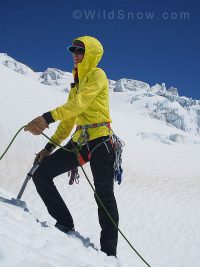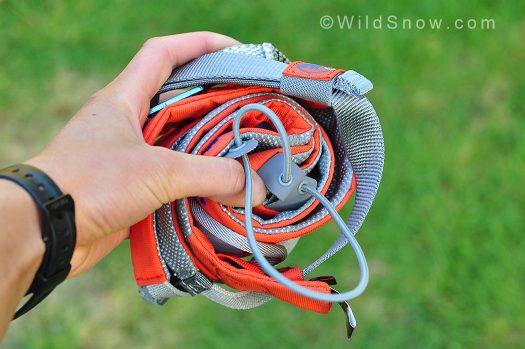Earlier this summer I wrote an first look review for the Mammut Zephir Altitude harness and have since been testing it on some of Washington State’s glaciated terrain. Most of the testing was in an academic outdoor education setting where we were repeatedly testing ourselves to failure with self-arrests on rope teams, crevasse rescues, ascending, and climbing. In other words, I spent a lot of time dynamically testing this harness.
The Mammut Zephir Altitude harness has a lot of really excellent qualities and has beat my expectations in terms of packability and weight. Features on this harness:
Each leg is adjustable from the front plastic coated metal buckles. These buckles are also easily undone to step into the harness when wearing skis or crampons — essential.
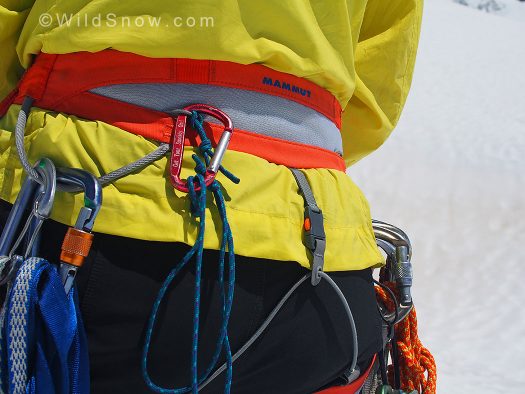
A drop seat in the back (don’t let your friends pull on the elastic cord, the recoil packs some tremendous snap! Photo by Eli Mauksch.
The belay loop is a slender loop of Dyneema — I had to learn to trust it the first time I jumped in a crevasse and now I feel that with proper care, it is an awesome way to shave bulk off of a harness. Just be careful of what you attach to it (I wouldn’t directly attach a rope or personal anchor to it for example, and keep in mind that Dyneema may be even more sensitive to heat failure than normal nylon type materials. Also, as with all harnesses watch closely for belay loop wear.)
Like many other mountaineering harnesses, the belay loop is permanently attached to the bottom part of the harness and the user has to pass the waist belt through the belay loop when putting it on.
What makes this harness unique is how the waist belt secures. The gray part of the buckle can stay adjusted to the diameter of your waist and all you do is slide it through the slot in the blue half of the buckle, line the two halves up parallel, and click them together. At first this system seemed too simple and not redundant enough, but now that I’ve used it, I feel it is very secure and it is really easy to fasten with gloves on.
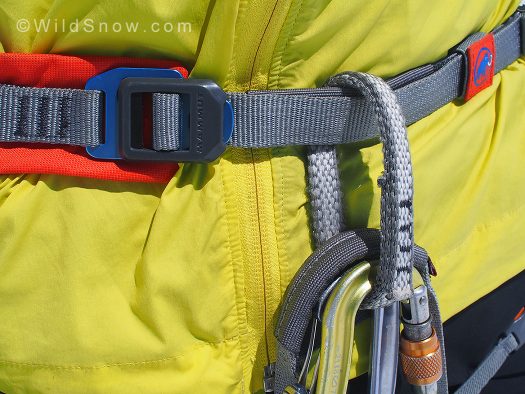
The lower plate (blue) on the buckle is aluminum and the upper plate (gray) is plastic coated steel. Photo by Eli Mauksch.
There are a couple places on this harness that are going to show wear and tear sooner than others. After only a few trips, I’m starting to see the beginning signs of these. Firstly, is the elastic band part of the leg buckle. Mine have already started to look overstretched and wiggly. Luckily, this is just a cosmetic flaw and does not really matter in the harnesses integrity. The second is that the Dyneema belay loop has started to appear fuzzy (see my warning above). As of right now, I have no concerns over it as I know it is just from the material’s tiny loops catching on other things, but as with all harnesses, I will continue to monitor its quality before each use.
One thing about this harness that I do not like is how it sits on my waist. Basically, the two legs that are hard sewn onto each side of the harness are a certain length and not adjustable. These two lengths of webbing determine where on your hips the harness sits based on how they wrap around your legs. Now I’m not sure if many other people would have this problem or not, but because of this it sits in a way that my hip bones are right at the junction of the waist belt and those two sewn in leg anchors. This means that when there is a lot of gear weighing down the belt or if I’m performing a crevasse rescue (when I’m holding the weight of another person in a self arresting position) all of the weight and friction is directly on my two hipbones instead of distributed throughout my waist and lower back.
Even with several layers of clothing padding the hip area, I have not found a way to make the Zephir more comfortable. I believe that this could be solved if the two leg anchors were sewn in further aft on the harness belt as to sit on padding rather than bone. Or I believe that if I had a thicker waist, the harness would be more opened up and the leg anchors would sit further towards my back (my size small harness is maximally cinched down to fit).
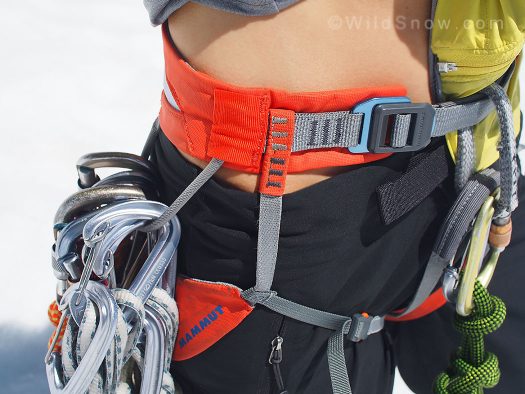
To show how the harness sits on my hips, I’ve removed the padding of my clothing. Both the gear loop and the leg anchor weigh down from the same junction on the belt, which causes a lot of friction and pressure on that one spot on my hips if I’m holding any weight. Photo by Eli Mauksch.
As far as general comfort goes, this harness is pretty good for what it is made for: traveling around in glaciated terrain, the rare crevasse rescue, belays, some lowers, and ski mountaineering. However, I wouldn’t ever want to use it for much else (ice cragging for example).
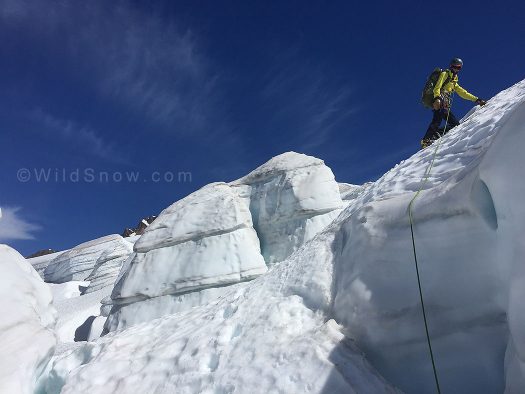
Traveling in the Mammut Zephir Altitude on fun terrain on the Easton Glacier on Mount Baker. Photo by J. Cole.
Shop for a Mammut harness here.
WildSnow Girl, Rachel Bellamy, skis, snowboards and does just about everything else that’s fun. Rachel calls the Pacific Northwest home but is often romping around the mountains and crags of other states she loves. Whether on snow, rock, or in the sea, this WildSnow Girl will frequently have a camera in hand to capture the bliss of adventure through photography. See her beautiful images on Instagram: birdrachel.

